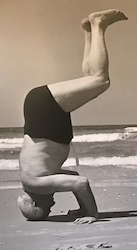Feldenkrais™ lessons can complement and transform a yoga practice. Feldenkrais focuses on letting go of unnecessary tension, refining movement patterns, and cultivating curiosity all while increasing overall ease and health.
One’s yoga practice can become not just easier, but more graceful and integrated – and fun!
There is a great deal of commonality in the underlying principles and practices. Both approaches emphasise awareness of breath, comfort, appreciation of elegance in movement and positions, as well as change and growth. Participants from both leave classes with a sense of increased wellness and ease.
Developed by Dr. Moshe Feldenkrais, this somatic education system uses gentle, systematic exploratory movements to enhance awareness, alignment, and functional ease. It engages the nervous system’s capacity for learning (the basis of neuroplasticity), enabling you to discover new, more effective ways to move and sense yourself.
The Feldenkrais Method™ is offered in two ways: classes (called Awareness Through Movement™ or ATM®) and individual sessions (called Functional Integration™ or FI®). This article refers mainly to the ATM classes. What is taught in a class is usually referred to as a “lesson”, which emphasises that the experience is intended to be a learning experience, and that the learning is related to changes in functioning.
Shared Emphasis on Breathing
Both yoga and the Feldenkrais Method place breathing at the heart of their practice. In Feldenkrais, attention to breath often reveals unconscious tension and habits that interfere with ease. Lessons may explore how subtle adjustments in moving the ribs or the rhythm of breathing reduced effort and improves alignment (see: What is Correct Breathing and Your Best Breath).
For instance, a student might discover how expanding awareness of breath during a twist allows the movement to unfold naturally, rather than forcing it, and consequently the person can twist further without strain. These discoveries resonate with yoga practitioners, deepening their connection to breath in asanas and meditation.
Overcoming Plateaus with Less Effort
The result can often be less ease and even injury. Many Yoga practitioners encounter plateaus in their practice, where progress seems elusive despite consistent effort. Often, these roadblocks stem from habitual movement patterns that limit flexibility or strength. Feldenkrais lessons can help let go of these limitations by introducing new movement pathways.
For example, in balancing poses like Tree Pose or Warrior III, doing lessons that apply Feldenkrais principles to reduce unnecessary muscular tension related to standing can improve stability and focus.
Dancing Between Effort & Ease
Can you dance between effort and ease? An oft-quoted aphorism in the Yoga Sutras is the sthira-sukham asanam, sutra 2.46, and is most commonly translated, “posture (asana) [should be] stable (sthira) and comfortable (sukha)[i]”. Similarly, Dr. Feldenkrais wrote, “In any coordinated, well-learned action we can distinguish certain features or recognize the following sensations”, two of which are: 1. Absence of effort; 2. Ease of breathing. In a way, his book, The Potent Self, can be read as reflections of the Yoga Sutras of Patañjali[ii] in daily life.
For example, in balancing poses like Tree Pose or Warrior III, applying Feldenkrais principles to attend to, and reduce unnecessary muscular tension can improve stability and focus.
Real-Life Stories: Healing and Transformation
Rachel Potasznik, a certified Yoga teacher, attended her first ATM class to address a chronic shoulder injury. Initially skeptical of the slow, subtle movements, she had a breakthrough when a tiny, deliberate shoulder movement suddenly released long-held tension. Her shoulder began to heal, inspiring her to train as a Feldenkrais teacher and integrate the method into her Yoga practice[iii].
Faye Berton, another Yoga teacher, had a similar experience. A practitioner of the rigorous Iyengar style, she initially struggled with the Feldenkrais emphasis on reducing effort. “To ask me to reduce effort was a real short-circuit,” she admitted. But over time, she noticed profound changes in her body awareness and capabilities, leading her to pursue certification as a Guild Certified Feldenkrais Practitioner™ [iv].
These stories highlight how Feldenkrais lessons help practitioners move past injury, limitation, and ingrained habits—unlocking new potential in their Yoga practice.
The Feldenkrais alternative to striving and efforting
Many people in society have a habit of applying effort and ignoring discomfort in order to achieve a pose. Students in ATM classes are invited to explore movement (and stillness) with curiosity and openness. They are encouraged to notice how they move to sense how this resonates through their whole body as they follow the suggested movement. This approach broadens their internal awareness, allowing them to refine movements and discover new possibilities. The result is not just improved function but a deeper sense of embodiment and presence.
Feldenkrais Lessons Are Often Done Lying Down
Unlike Yoga, which works primarily in upright postures, Feldenkrais lessons often take place lying on the floor. This creates an environment where students can focus entirely on sensing and refining movement without the added challenge of maintaining balance.

Near the end of a class, students are often invited to experience the movements upright.
For Yoga practitioners, this can reveal subtle patterns of tension that affect standing poses or transitions. For example, through experiencing a classic Feldenkrais lesson titled “The Pelvic Clock”, a yoga student can improve stability and alignment in Warrior Pose or Downward Dog. By removing habitual compensations, students gain new insights into how their body works as a whole.
Practical Benefits for Yoga Practitioners
The integration of Feldenkrais and Yoga offers tangible benefits:
- Refining Alignment: ATM lessons clarify errors in alignment thus improving asanas.
- Overcoming Plateaus: By introducing new movement patterns, students can release physical or mental barriers in their practice.
- Reducing Effort: The emphasis on ease transforms poses that once felt difficult or strained into graceful, sustainable movements.
- Deepening Awareness: Both practices cultivate mindfulness, and the Feldenkrais Method offers unique tools for sensing the body’s interconnections in real-time.
Applying Awareness Though Movement (ATM) lessons in Yoga classes
Many yoga teachers who have participated in ATM lessons find that they can bring some of the lesson sequences into their practice. The ubiquitous “Pelvic Clock” lesson developed by Dr. Feldenkrais is now explored in many yoga classes. It is not uncommon to find yoga teachers implementing a sequence they learned in ATM classes to help their students find comfort in approaching a pose.
Closing Invitation
Yoga and the Feldenkrais Method share a common goal: enhancing strength, flexibility, balance, and presence. By blending these practices, practitioners can move beyond effort and strain to discover ease, grace, and integration in both movement and life. Experience this synergy for yourself.
Why not start with a session today and see how it complements your Yoga practice? I invite you to explore further with the free introduction to the Feldenkrais Method available online at: (https://somaticjourneys.thrivecart.com/free-introduction/) This includes a full lesson so that you can experience many of these aspects, as well as three short (5-10-minute) lessons specifically designed to free the neck, free the jaw and reduce stiffness in the hips and spine.
References
[i] See: https://www.ekhartyoga.com/articles/practice/sthira-and-sukha-finding-balance-on-and-off-the-mat
[ii] For example: https://www.swamij.com/yoga-sutras-list.htm
[iii] My Journey from Yoga to Feldenkrais® and Back Again, By Rachel Potasznik https://feldenkrais.com/my-journey-from-yoga-to-feldenkrais-and-back-again-by-rachel-potasznik/
[iv] Improving Yoga Asana With Feldenkrais – Interview With Faye Berton. Video on Youtube: https://www.youtube.com/watch?v=JdwKH7wbwgk





